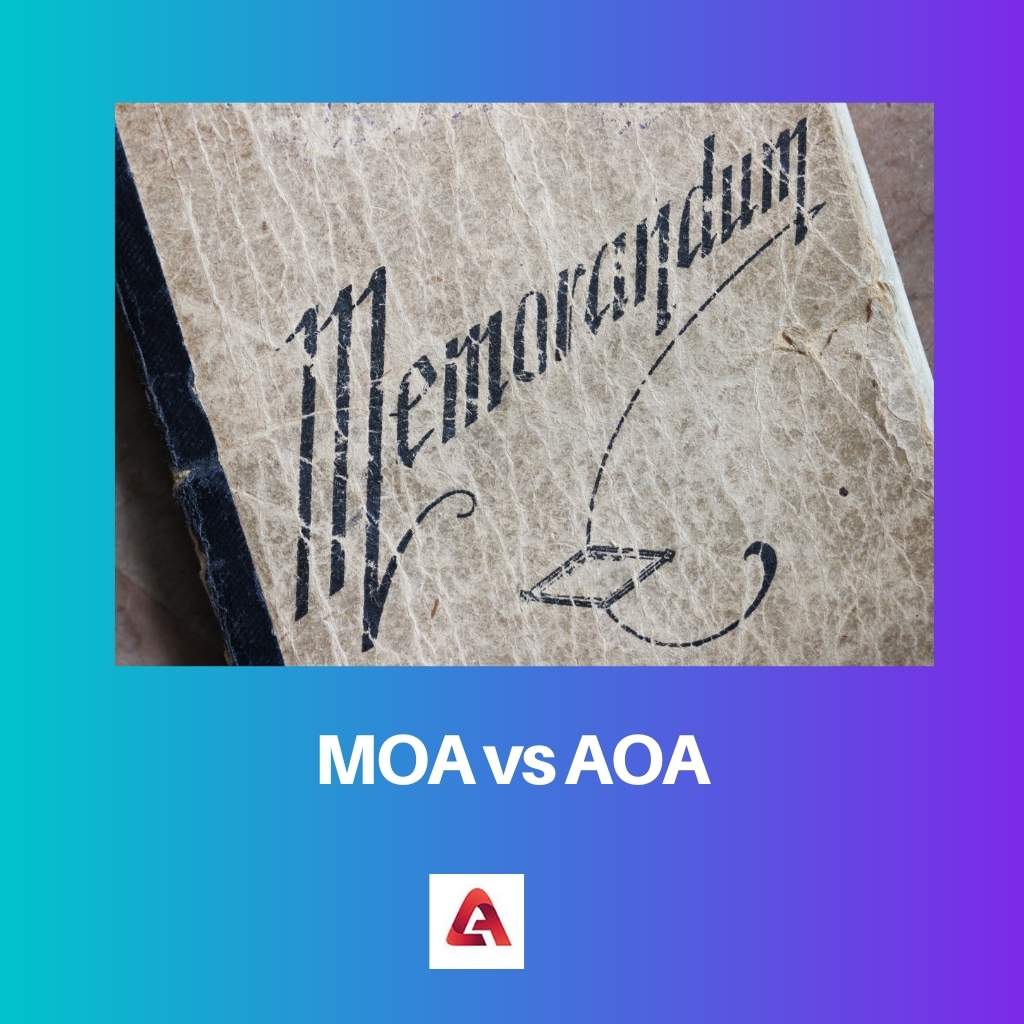The MOA outlines the company’s fundamental objectives, defining its scope of operations and activities. On the other hand, the AOA details the internal regulations and rules guiding the company’s day-to-day operations, including procedures for meetings, appointment of directors, and shareholder rights.
Key Takeaways
- MOA stands for Memorandum of Association, while AOA stands for Articles of Association.
- MOA outlines a company’s fundamental principles and objectives, while AOA details the company’s internal governance structure.
- MOA is a public document filed with the government during company registration, while AOA is a private document that is not required to be filed.
MOA vs AOA
MOA means Memorandum of Association and is a chartered document that includes information on the incorporation of a company and its relationship with outside forces. AOA stands for Articles of Association and is a chartered document that specifies the rules for running a company and its internal relationships.

MOA is a chartered document that maps out what the company is essentially made of and its objectives. Relations with outside forces are also mentioned in this. It is a legal necessity during the initial set-up phase of a corporate entity.
Once made, it cannot be amended. The document is made in compliance with the Company act.
AOA is another chartered document that maps out all the rules and regulations that need to be followed by the company. It defines the internal working of the organization. However, only private companies are legally bound to prepare it.
The document can be amended as per needs. It is made as a secondary to the memorandum.
Comparison Table
| Feature | MOA (Memorandum of Association) | AOA (Articles of Association) |
|---|---|---|
| Purpose | Defines the company’s existence and outlines its fundamental details | Defines the internal governance structure and operational rules of the company |
| Content | * Company name and registered office address * Objectives of the company (business activities it can undertake) * Liability clause (limited or unlimited) * Capital clause (authorized share capital) * Association clause (agreement to form the company) | * Defines the rights and duties of shareholders * Defines the powers and duties of directors and company secretary * Meeting procedures (shareholders’ meetings and board meetings) * Transfer and allotment of shares * Dividend distribution policy * Company’s internal management procedures |
| Mandatory | Yes, for all companies | Mandatory for private companies; Public companies can adopt a model set of regulations (Table F) |
| Amendments | Difficult to amend, requires approval from the Registrar of Companies and court | Easier to amend by special resolution of the shareholders |
| Hierarchy | Supreme document, overrides AOA | Subordinate to MOA and the Companies Act |
| Publicity | Public document, available for inspection | Private document, not publicly available |
What is MOA?
The Memorandum of Association (MOA) serves as a foundational document for a company, outlining its scope, objectives, and essential features. It is a legal prerequisite during the company registration process and establishes the company’s constitution. This document essentially defines the company’s raison d’être and sets the boundaries within which the company can operate.
Key Components
1. Name Clause
The MOA begins by specifying the name of the company, which must be unique and compliant with the relevant regulations. This clause ensures clarity and distinction, avoiding any potential confusion with existing entities.
2. Registered Office Clause
This clause outlines the address of the company’s registered office. It provides the official location where legal notices, communications, and official documents can be sent. Companies are required to maintain a registered office within the jurisdiction of incorporation.
3. Object Clause
In the Object Clause, the company details its primary and ancillary objectives. These objectives define the scope of the company’s activities, and any deviation outside these boundaries requires an alteration to the MOA, subject to legal approval.
4. Liability Clause
This clause specifies the type of liability the company’s members have in the event of winding up. Companies can have limited liability, where the liability of members is restricted to the amount unpaid on their shares, or unlimited liability, where members are personally responsible for the company’s debts.
5. Capital Clause
The Capital Clause outlines the authorized capital of the company, which represents the maximum amount of capital the company can raise through the issuance of shares. It also specifies the types and classes of shares that the company is authorized to issue.
6. Association Clause
The Association Clause signifies the members’ intention to form a company and their agreement to become members. Each subscriber’s signature indicates their consent to be part of the company and abide by its regulations.
Alteration and Amendment
The MOA can be amended or altered under specific legal procedures. Changes to the name, registered office, object clause, or capital clause necessitate the approval of the shareholders and regulatory authorities. Any modifications must align with the company’s interests and legal requirements.
What is AOA?
The Articles of Association (AOA) represent a crucial document that outlines the internal regulations and rules governing a company’s operations and management. It works in conjunction with the Memorandum of Association to form the constitution of a company, guiding its internal affairs.
Key Components of Articles of Association
1. Objectives and Purposes
The AOA elucidates the company’s objectives and purposes, specifying the scope of its activities. It serves as a blueprint for the company’s operations and defines the boundaries within which it can function.
2. Share Capital and Shareholders’ Rights
This section delves into the details of the company’s share capital, including the types of shares issued and their respective rights. It outlines the procedures for issuing, transferring, and buying back shares, ensuring transparency in shareholder dealings.
3. Management and Board Structure
The AOA establishes the framework for the company’s management and governance structure. It outlines the powers and responsibilities of the board of directors, their appointment procedures, and the overall decision-making processes within the company.
4. Meetings and Voting Procedures
This section details the protocols for conducting meetings, both general and board meetings. It covers the quorum requirements, voting procedures, and the resolutions needed for various corporate actions, fostering a systematic approach to decision-making.
Importance of Articles of Association
1. Legal Compliance
The AOA ensures that the company operates within the legal framework, adhering to the regulations and guidelines set by the relevant authorities. This compliance is essential for the company’s sustainability and reputation.
2. Protection of Shareholders’ Interests
By clearly defining the rights and obligations of shareholders, the AOA safeguards their interests. It establishes a fair and transparent system for the distribution of profits, dividends, and voting rights, fostering trust among shareholders.
3. Flexibility in Operations
While the Memorandum of Association provides a broad outline, the AOA offers flexibility in structuring internal affairs. It allows the company to adapt to changing circumstances and business environments without necessitating changes to the Memorandum.
Amendment of Articles of Association
Companies can alter their AOA by passing a special resolution during a general meeting. This flexibility enables companies to adapt to evolving business landscapes, but amendments must adhere to legal requirements and shareholder interests.
Main Differences Between MOA and AOA
- Definition:
- MOA (Memorandum of Association): It is a legal document that outlines the company’s constitution and the scope of its activities. It defines the company’s objectives, powers, and the types of business it can engage in.
- AOA (Articles of Association): AOA complements the MOA, providing detailed rules and regulations for the internal management and day-to-day operations of the company. It covers matters such as the appointment of directors, their powers, shareholder rights, and meetings.
- Scope:
- MOA: Focuses on the external aspects of the company, defining its relationship with the outside world, including its objectives and permissible activities.
- AOA: Concerned with the internal workings of the company, specifying how the organization will be run, the roles and responsibilities of its members, and the decision-making processes.
- Alteration:
- MOA: Changes to the MOA often require approval from regulatory authorities and shareholders, as it involves amendments to the company’s fundamental structure and objectives.
- AOA: Amendments to the AOA are relatively more flexible and typically need approval from the board of directors and shareholders, depending on the company’s internal regulations.
- Contents:
- MOA: Includes details such as the company’s name, registered office, objectives, capital clause, liability clause, and association clause.
- AOA: Contains provisions related to the issuance and transfer of shares, procedures for meetings, appointment and powers of directors, dividends, borrowing powers, and other internal regulations.
- Legal Status:
- MOA: Holds a higher legal significance as it defines the company’s existence and its purpose. Any activities outside the MOA’s scope are deemed ultra vires (beyond the legal power) and may be void.
- AOA: Carries importance but is subordinate to the MOA. It deals with the internal governance and management of the company.
- Public Access:
- MOA: Generally available for public inspection as it outlines essential information about the company’s identity and purpose.
- AOA: Often not accessible to the public. It’s an internal document that governs the relationships between the company and its members.
- Separate Documents:
- MOA and AOA: While closely related, MOA and AOA are distinct documents. The MOA is filed during the company’s registration, while the AOA is formulated to complement the MOA and is often customized to suit the company’s internal structure.





